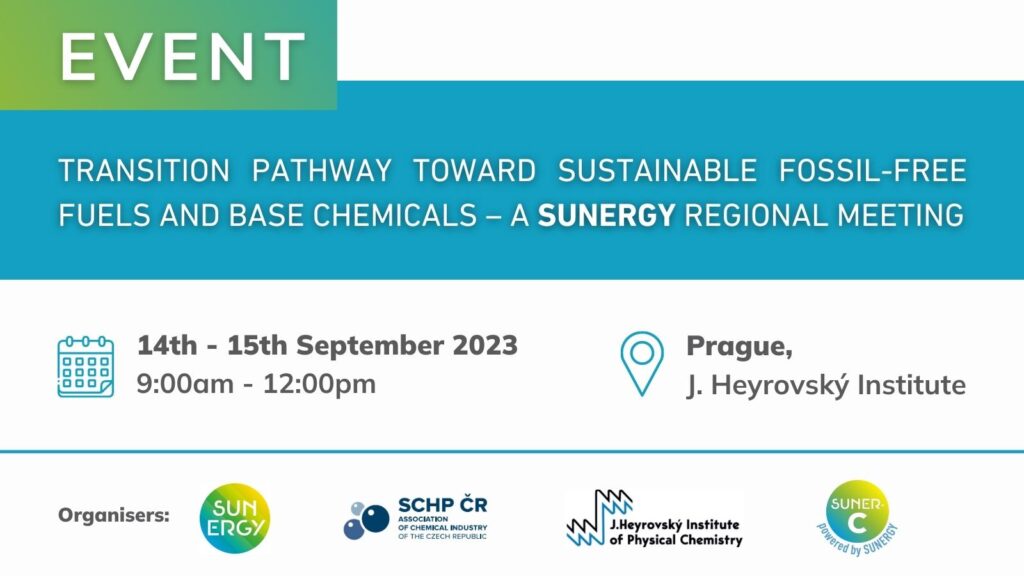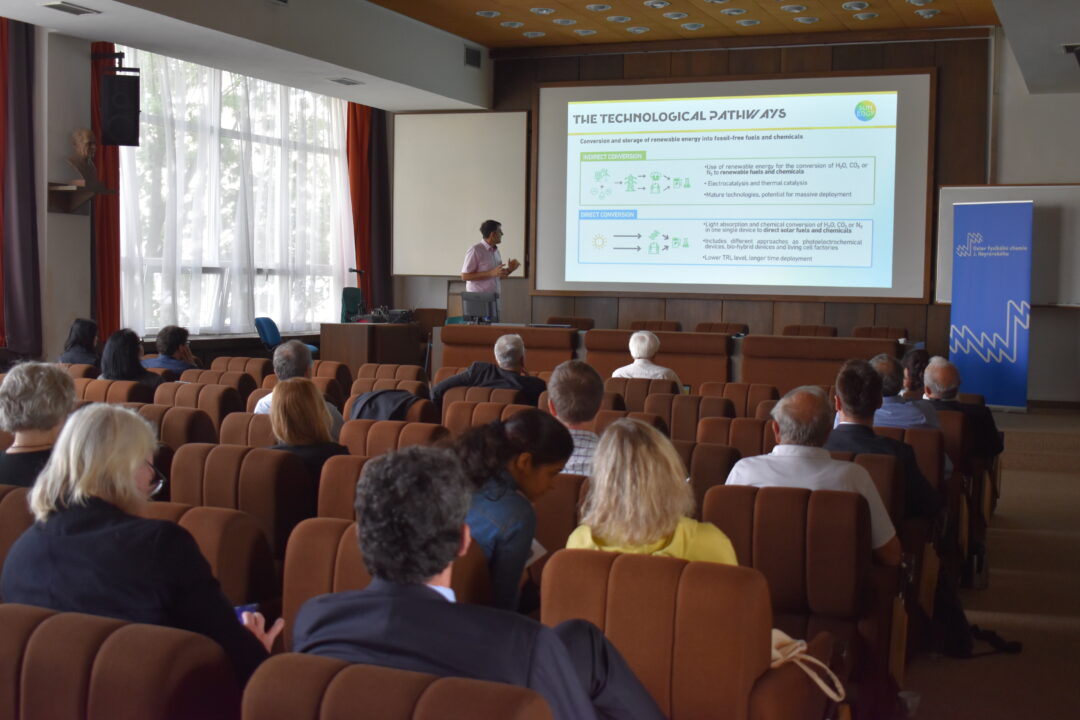“Transition pathway toward sustainable fossil-free fuels and base chemicals” is a title of a conference that was jointly organized by the J. Heyrovský Institute of Physical Chemistry (Czech Academy of Sciences), Association of Czech Chemical Industry, and the European initiative SUNERGY. It was held at the J. Heyrovský Institute in Prague on 14 and 15 September 2023.
The conference was a very interesting event that brought together people from academia, industry, as well as from organizations supporting Czech participation in Horizon Europe. The industry participation ranged from large companies such as ORLEN-Unipetrol or BASF to new startups, for example TailorMem (CZ) that specializes in developing and producing new types of membranes. Academic participation involved mostly scientists from the J. Heyrovský Institute and other institutes of the Czech Academy, and from the University of Chemistry and Technology in Prague. Altogether, the meeting was attended by about 70 participants, mostly from the Czech Republic as well as from France, Poland, Finland, and Spain.
Such a broad and diverse participation allowed to present and discuss a range of scientific, technical, economical, and political issues related to synthetic fuels – energy-rich chemical compounds (such as hydrocarbons, methanol, hydrogen, etc.) produced from abundant raw materials (CO2, water, nitrogen) with the use of sunlight (solar fuels) or renewable electricity (e-fuels). Making such fuels from CO2 would make them carbon-neutral and their wide usage would become a basis for a circular economy of the future.

Scientific talks covered a broad range of topics, from the general need of synthetic fuels, their merits as well as downsides, to particular processes and technical solutions to produce and utilize various kinds of sustainable fuels and feedstock chemicals. Using detailed analysis and hard numbers quantifying energy requirements, it was clearly shown that liquid synthetic fuels will be an absolutely necessary part of transition to fossil-free energetics, especially in the context of the Czech Republic. This is not just to provide energy for transportation (while using the existing infrastructure) but also to store intermittent renewable energy for a long time and to maintain the stability and resilience of the energy systems of European countries, and to contribute to their energetic sovereignty. Development of technologies for energy storage in chemical bonds of synthetic fuels should thus be regarded as a foremost strategic goal of European countries and the EU. An important point has been made that synthetic fuels have to be primarily judged and evaluated by their energy efficiency. In other words, more energy has to be gained than conventional energy spent on their production.
Several talks have clearly demonstrated that presently known fuel-producing processes do not match the strict requirements of material and energy efficiencies and that entirely new approaches are needed. This conclusion mandates establishing strong research and development programs on national as well as European levels. As was presented by its deputy coordinator Frédéric Chandezon, SUNERGY (one of the meeting organizers) is an European initiative that, together with the Horizon Europe Coordination and Support Action SUNER-C, strives to build up an EU-wide community working on synthetic (solar) fuels, promote them, and, most importantly, establish an EU large-scale research initiative (most likely a co-programmed partnership) that will fund and coordinate European research, technology development and transfer, as well as upscaling and implementation of synthetic fuels in the energetics of EU countries and beyond. Toward this goal, SUNER-C (supported by the broader SUNERGY community) works on a roadmap, which was explained in dedicated talk. It is an open document that responds to latest scientific/technical developments as well as to evolving political and societal views. Since it is too early to “pick winners” by deciding which synthetic fuels and production processes are most promising, the roadmap rightly stresses the need to pursue the research and development along multiple parallel lines, even including emerging novel aspects of photon management, light-matter interactions, as well as photo- and electro-catalysis. Some of the technical issues raised in the roadmap were addresses by specific scientific/technical talks. Water oxidation (either electro- or photochemical) complements all practically considered fuel-producing processes but also presents their bottleneck. Physical/chemical origins of the water-oxidation problem were analyzed in one of the talks that also outlined the way forward by theory-guided development of new catalytic materials.
On the hydrogen-evolution and CO2 reduction side, there was a very interesting talk on nanostructured 2-dimensional catalytic materials, including metal-doped graphene and molybdenum and rhenium sulfides, where catalytic sites occur at nanosheet edges. Photoelectrochemical CO2 reduction to hydrocarbons was shown to occur catalytically on copper-doped polydopamine on hydroxylapatite sheets. Doped organic semiconductors and metal-organic frameworks combining light-harvesting and catalytic sites were presented among new promising systems for artificial photosynthesis. Photobiology presents and alternative approach, whereby immobilized cyanobacteria reduce nitrogen or CO2 using electro- or photochemically supplied electrons. Talks on innovative technical solutions dealt with coelectrolysis of CO2 and steam on solid oxides and described new types of ion-exchange membranes that are now getting employed in electrocatalytic systems and batteries, as well as in novel systems producing electricity upon mixing sea and fresh water. Several talks also stressed the importance of designing photoreactors and electrolytic cells aimed at improving energy and material efficiencies.
Progress toward synthetic fuels is to a large extent contingent upon advances in materials research that is bringing new catalysts, separators, etc. On an EU level, energy-related material research is represented by the AMPEA program of the European Energy Research Alliance (EERA), whose activities were overviewed. Important activities take place also at the national level as was demonstrated by talks on the “CO2 Czech Solution Group” and the “Strategy AV21” of the Czech Academy of Sciences. The CO2 Group explores ways to convert CO2 into feedstock chemicals for industry and aims to create a cooperative environment encompassing industry, R&D, as well as the government, and also to involve Czech Republic in international cooperation on low-carbon and circular economy. Strategy AV21 outlines the principal research directions of the Czech Academy of Sciences and, in selected directions, fosters synergies between Academy institutes as well as between disciplines. It also aims to improve public awareness and facilitate knowledge transfer to the educational and private sector. The Strategy is organized into programs, one of which, “Sustainable Energy”, is directly relevant to synthetic fuels. It focuses on hydrogen and “new fuels”, CO2 capture, as well as on energy storage. Specific research projects in Academy institutes include, for example, mechanism of (photo)electrochemical water oxidation, development of catalytic materials and membranes for electrolyzers, hydrogen storage, membranes for CO2 capture, methane-to-methanol and CO2-to-ethanol conversions, as well as unravelling fundamental principles of light harnessing and energy conversion.
Finally, a citation from the talk given by Ivan Souček, director of the Czech Industry Association: “…reducing greenhouse gas emissions, increasing resource efficiency and circularity, safety in the chemical industry …. will require new process technologies and their combination will be essential to achieve the EU’s 2050 climate-neutrality objective.”

